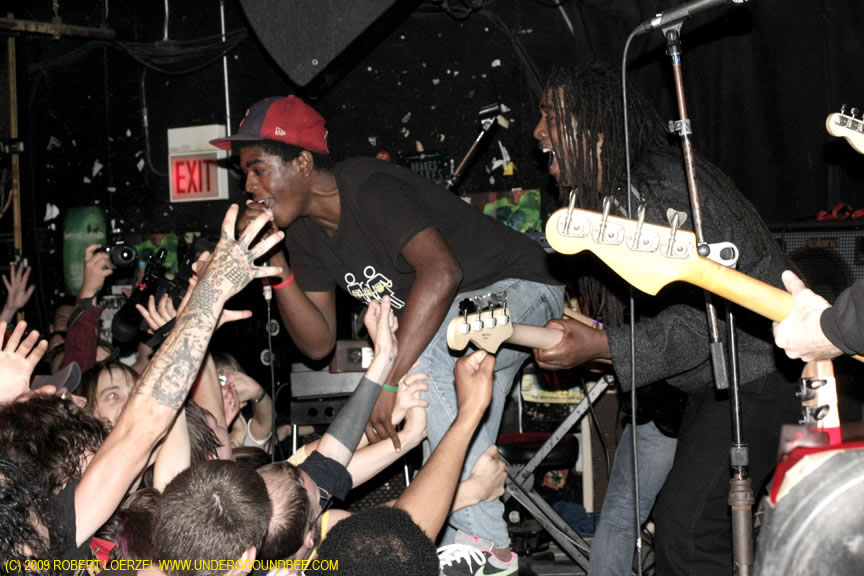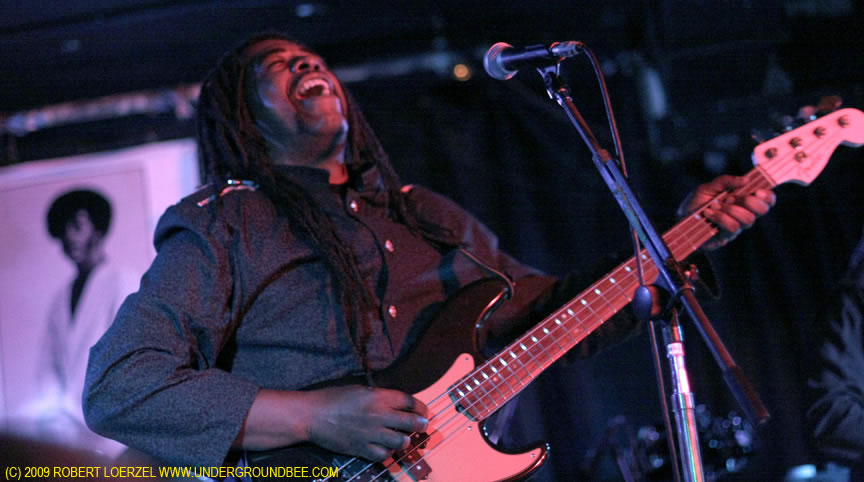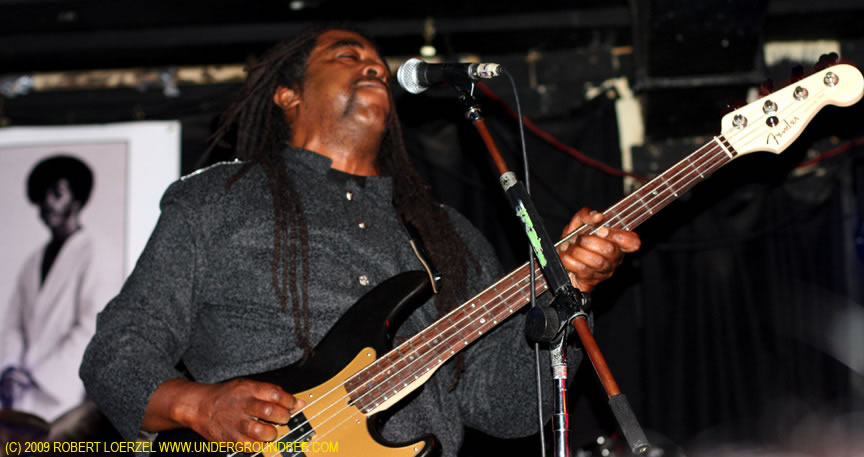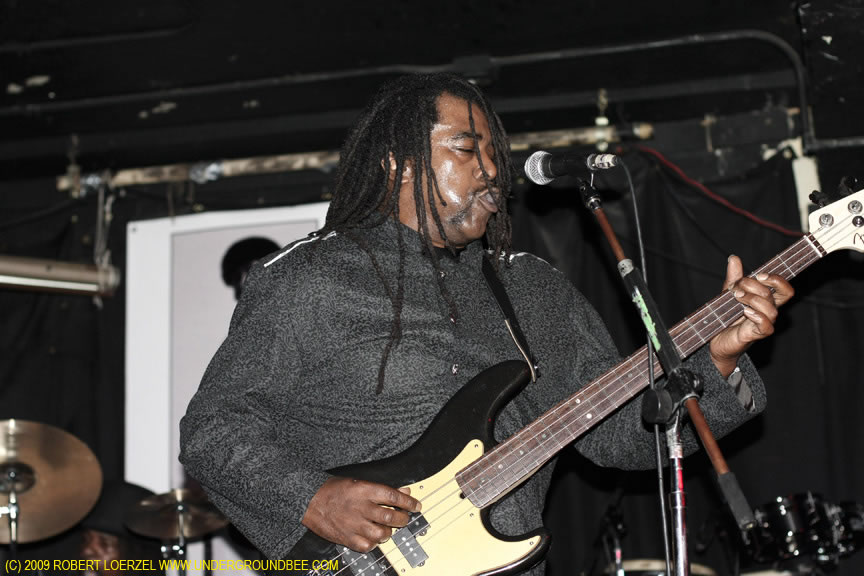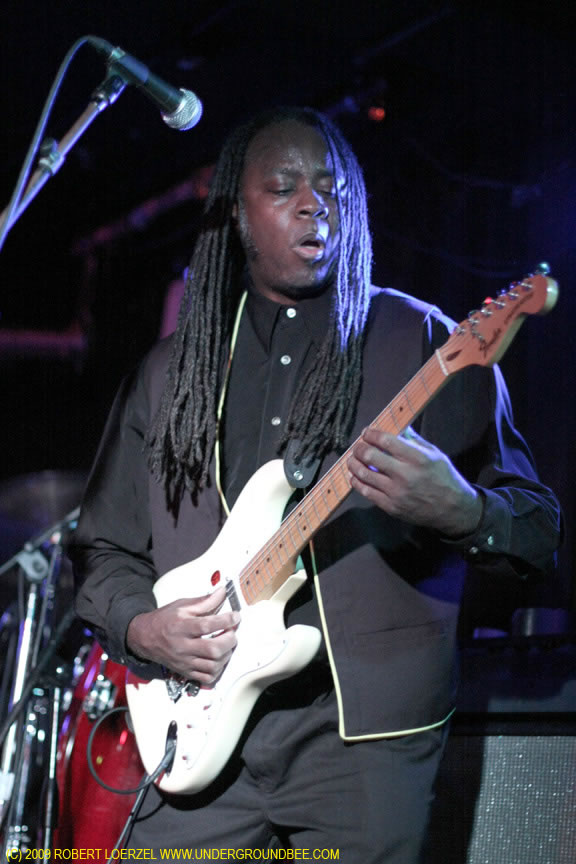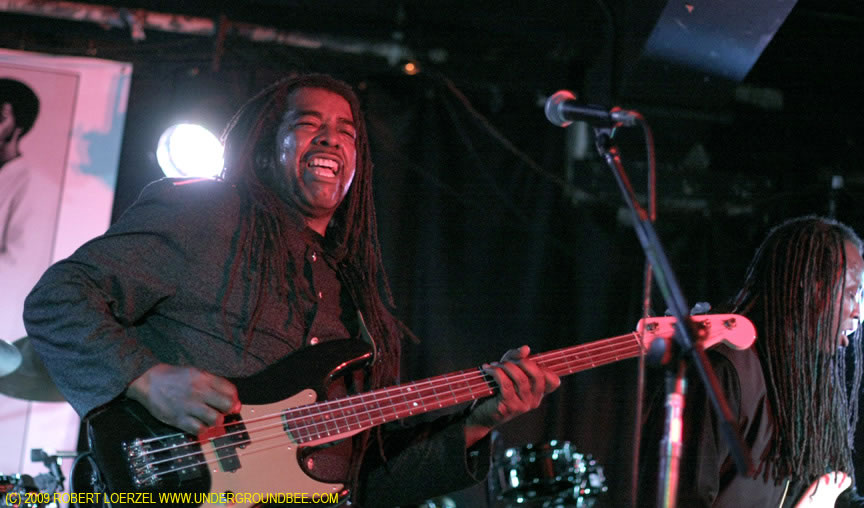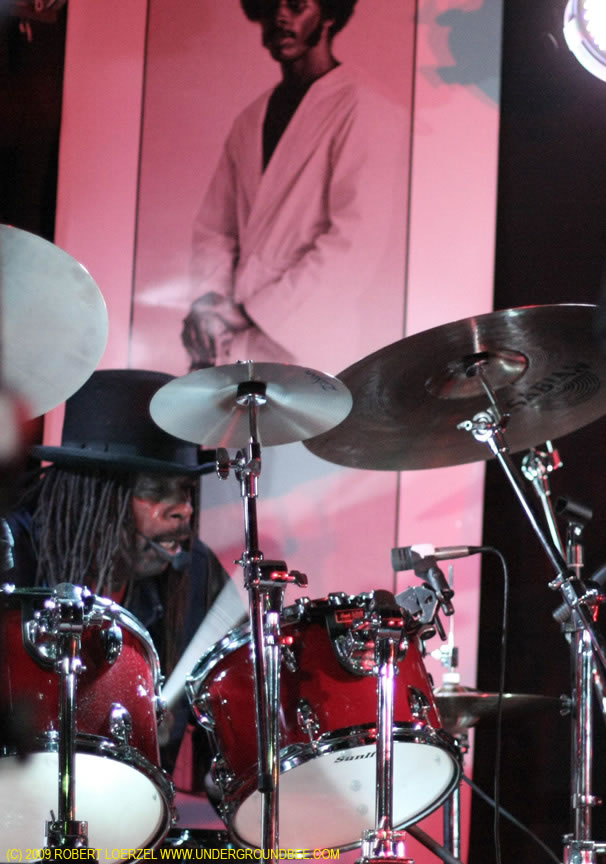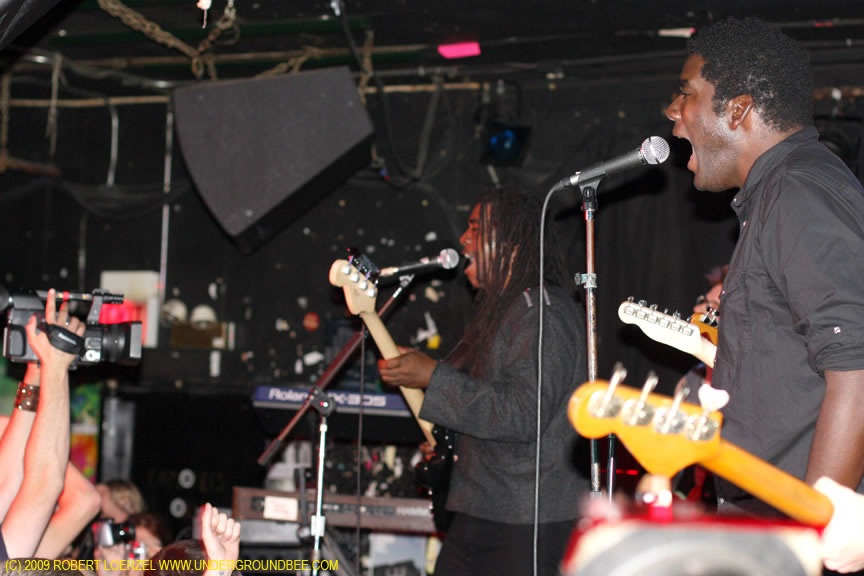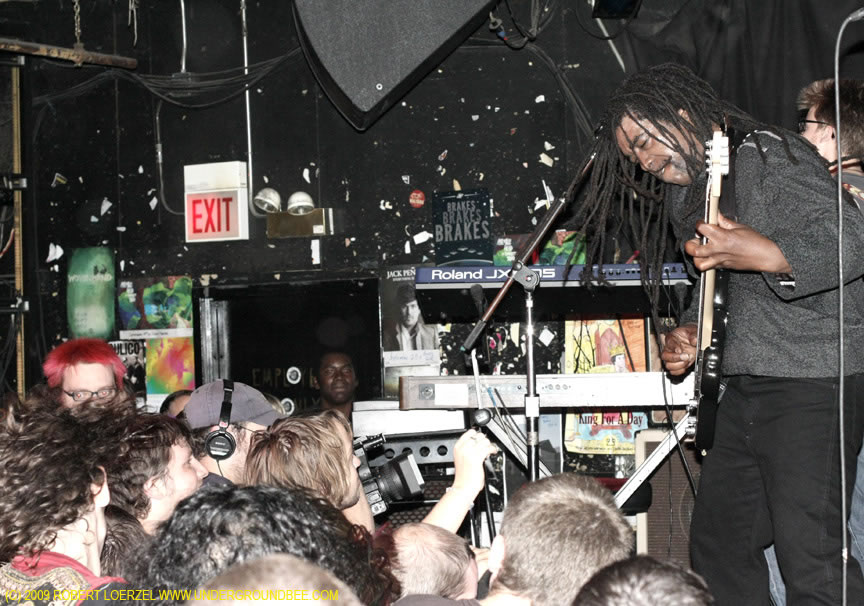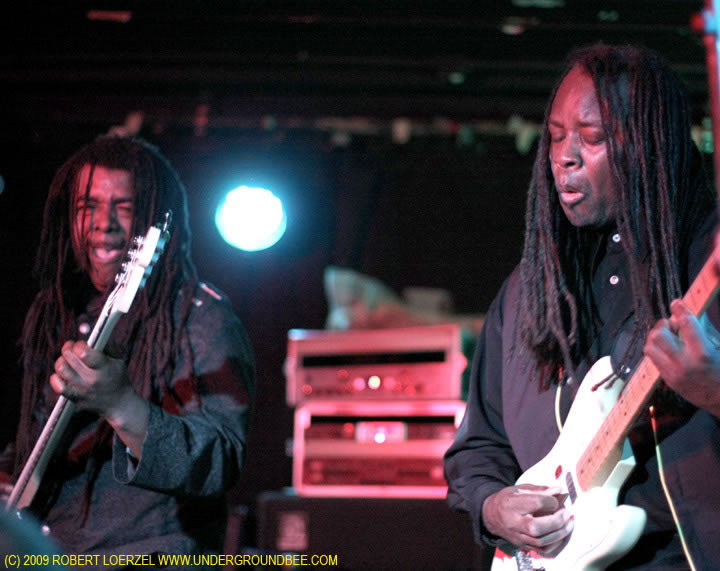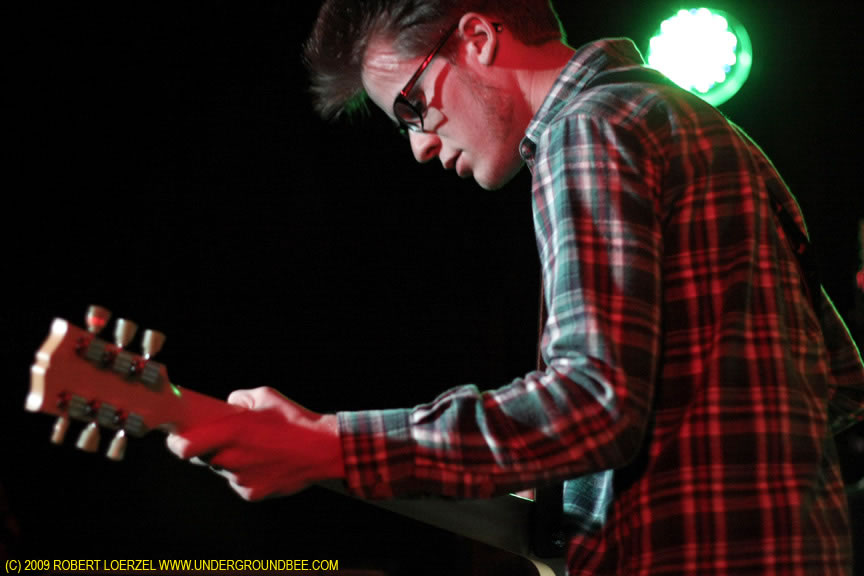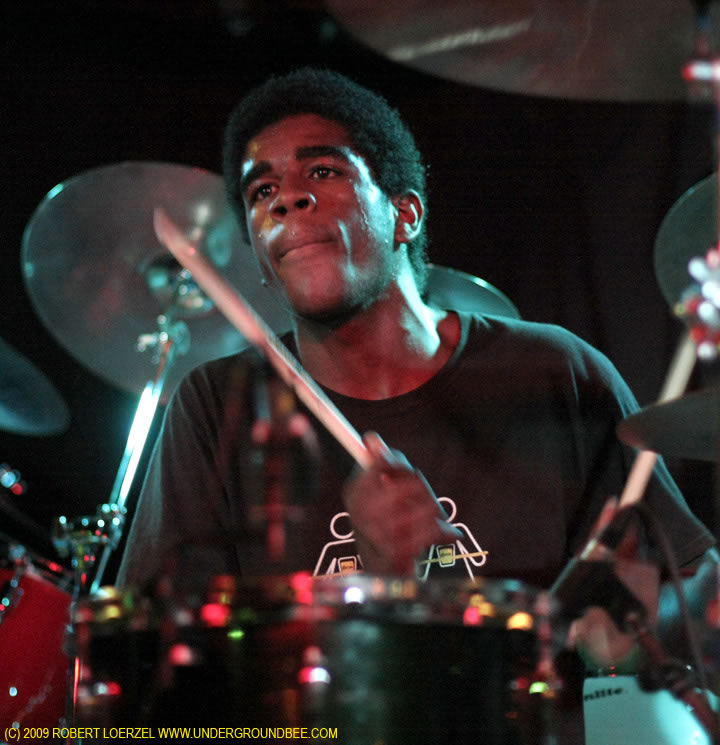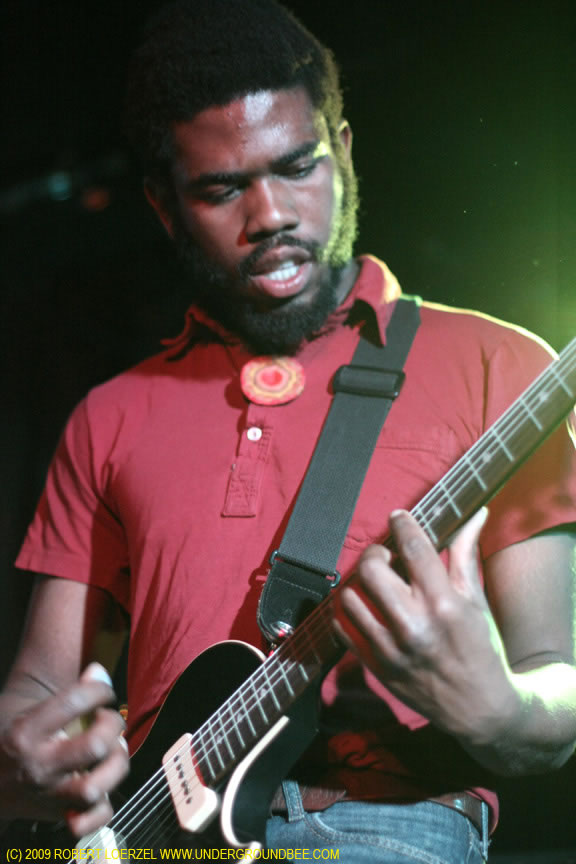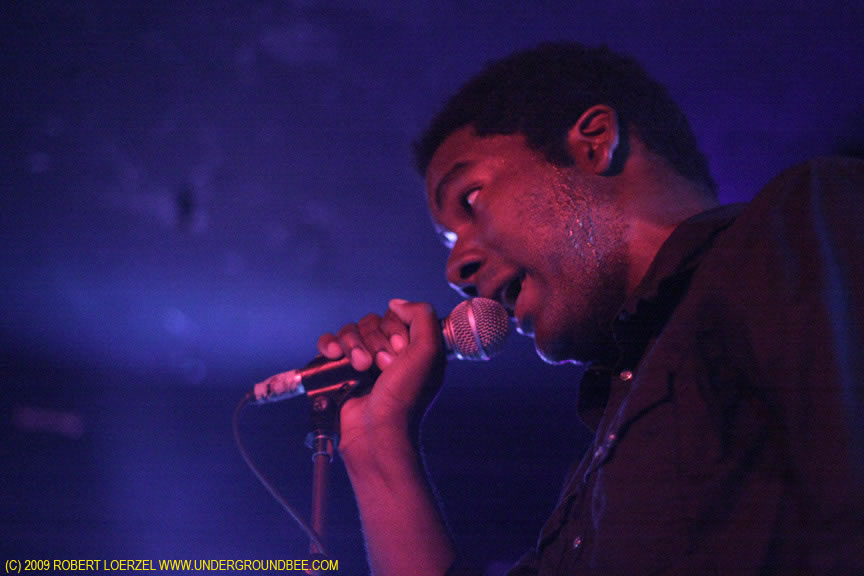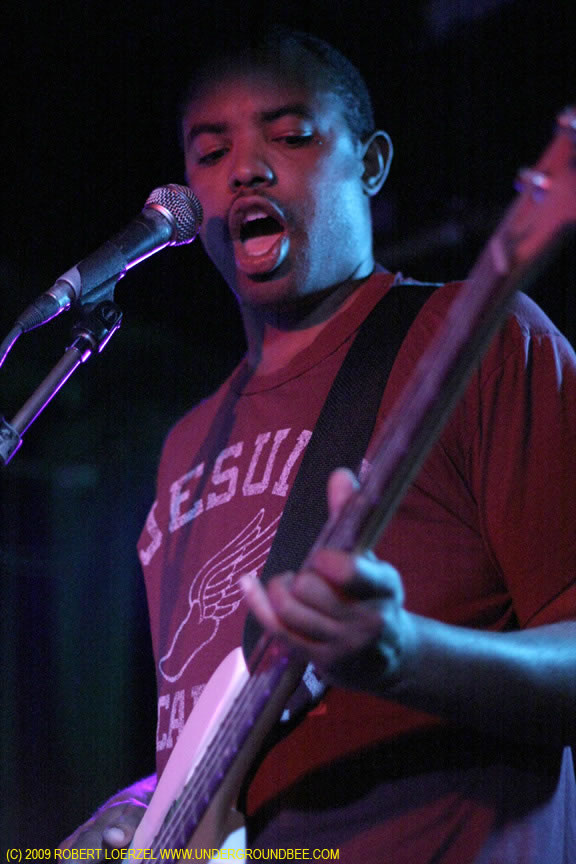What I saw on day three of the Pitchfork Music Festival:
The first half of this day, I was too peripatetic to absorb full sets of music. Rushing around, trying to get pictures, I feel like I did not experience enough of the music. That’s my own fault… though I do sometimes long for music festivals without so much overlapping music.
In the first part of the day, I caught a few songs by The Mae Shi, which seemed rather jagged. And a few songs by Michael Columbia, which seemed more like artsy jazz rock. Kind of interesting.
 Frightened Rabbit put on a strong set — I did catch almost most of that one. The studio recordings by Frightened Rabbit don’t thrill me all that much, but they’re awfully good as a live act. Vocalist Scott Hutchinson really gives his all, singing with terrific intensity and whipping around his guitar at the climax of the songs.
Frightened Rabbit put on a strong set — I did catch almost most of that one. The studio recordings by Frightened Rabbit don’t thrill me all that much, but they’re awfully good as a live act. Vocalist Scott Hutchinson really gives his all, singing with terrific intensity and whipping around his guitar at the climax of the songs.
 Blitzen Trapper were good, too. At times, this band seems a bit too much like the cheesier aspects of early ’70s country, folk and Southern rock, but when they hit their mark with a good song, like “Furr,” it sounds marvelous. A sunny park was a good setting to hear their harmonies.
Blitzen Trapper were good, too. At times, this band seems a bit too much like the cheesier aspects of early ’70s country, folk and Southern rock, but when they hit their mark with a good song, like “Furr,” it sounds marvelous. A sunny park was a good setting to hear their harmonies.
I wanted to see the sets across the park by two Chicago bands, Dianogah and the Killer Whales, but getting back and forth started to become a hassle. I did see Dianogah long enough to grab a couple of photos.
 Pharoahe Monch is a hip-hop act I was not familiar with, but I liked what I heard of his set. He had a good rapport with the crowd and his personality came through onstage, which is key at any hip-hop concert.
Pharoahe Monch is a hip-hop act I was not familiar with, but I liked what I heard of his set. He had a good rapport with the crowd and his personality came through onstage, which is key at any hip-hop concert.
Women were playing across the park, and I caught just a few songs. I saw Women previously at the Bottom Lounge, and their record is pretty good. There’s something strange and slightly twisted about their music. I’m wondering if it will develop into smoother or stranger stuff as the band develops.
 The Thermals rocked out with a lively set. And hey, I did see all of this show. I was surprised that they included so many covers in their set, including songs by Sonic Youth, Nirvana and Green Day, but hey, what the heck. Judging from the hard-hitting melodic punk-pop sound of the Thermals, those are all probably songs that the band loves to hear, so why not play them?
The Thermals rocked out with a lively set. And hey, I did see all of this show. I was surprised that they included so many covers in their set, including songs by Sonic Youth, Nirvana and Green Day, but hey, what the heck. Judging from the hard-hitting melodic punk-pop sound of the Thermals, those are all probably songs that the band loves to hear, so why not play them?
 The Walkmen played a pretty impressive set, from what I saw and heard (which was the first three songs and the last couple of songs). I’ve always liked their intensity, and that came through in this performance for sure. It looked like singer Hamilton Leithauser might burst some of the blood vessels in his neck at the rate he was going. I gladly would have watched the entire Walkmen set, but I wanted to see…
The Walkmen played a pretty impressive set, from what I saw and heard (which was the first three songs and the last couple of songs). I’ve always liked their intensity, and that came through in this performance for sure. It looked like singer Hamilton Leithauser might burst some of the blood vessels in his neck at the rate he was going. I gladly would have watched the entire Walkmen set, but I wanted to see…
 Japandroids — Wow! I like the debut record by this guitar-and-drums duo from Vancouver (it comes out Aug. 4 in the U.S. on Champaign-based Polyvinyl), but I wasn’t prepared for how exciting the live show would be. First of all, from the standpoint of a photographer, it’s great when musicians jump around and shake their hear. Not only did guitarist Brian King do that — he also had a fan blowing back his hair! And he liked to climb up onto the drum riser to get closer to his bandmate, David Prowse. There was so much energy on that stage, it was impossible not to have fun watching it.
Japandroids — Wow! I like the debut record by this guitar-and-drums duo from Vancouver (it comes out Aug. 4 in the U.S. on Champaign-based Polyvinyl), but I wasn’t prepared for how exciting the live show would be. First of all, from the standpoint of a photographer, it’s great when musicians jump around and shake their hear. Not only did guitarist Brian King do that — he also had a fan blowing back his hair! And he liked to climb up onto the drum riser to get closer to his bandmate, David Prowse. There was so much energy on that stage, it was impossible not to have fun watching it.
For the rest of the day, I stayed on the north end of the park and watched the two main stages. Alas, this meant missing the bands playing down on the B stage: DJ/Rupture, Vivian Girls, Mew and the Very Best. I was especially hoping to see the lovely Vivian Girls in daylight for a change from the dimly lit SXSW show I saw. Oh, well… The park was too jam-packed to get back and forth easily. And besides, I did want to hear the full sets by the bands playing on the big stages.
 M83 showed how you can make electronic pop music rock. Main man Anthony Gonzalez twiddled knobs on his electronic gear, played guitar and sang, while Morgan Kibby (who had a strip of blue across her face around the eyes) added lovely vocals, helping the songs to soar at key moments. The drummer played behind a clear-plastic shield.
M83 showed how you can make electronic pop music rock. Main man Anthony Gonzalez twiddled knobs on his electronic gear, played guitar and sang, while Morgan Kibby (who had a strip of blue across her face around the eyes) added lovely vocals, helping the songs to soar at key moments. The drummer played behind a clear-plastic shield.
 Grizzly Bear is a band I admire without completely loving. Their new CD, Veckatimest, is quite good, with lots of Brian Wilson-esque touches, though the band always seems to hold back a little bit from delivering the big choruses it’s undoubtedly capable of. The aim seems to be more mysterious, ethereal music that flirts with pop. The crowd on Sunday evening applauded vigorously when Grizzly Bear took the stage, and the set did seem a little livelier than previous Grizzly Bear concerts I’ve seen. They let the songs rock a bit more than usual, which was a good thing. But for most of the Grizzly Bear concert, I was standing across the field, waiting for my chance to get into the Flaming Lips photo pit. The Lips’ stage crew and Wayne Coyne himself were getting their stage ready by this point, which was pretty distracting. I tried to pay attention to what Grizzly Bear was playing across the park, but it started to get lost in the anticipation for the Flaming Lips.
Grizzly Bear is a band I admire without completely loving. Their new CD, Veckatimest, is quite good, with lots of Brian Wilson-esque touches, though the band always seems to hold back a little bit from delivering the big choruses it’s undoubtedly capable of. The aim seems to be more mysterious, ethereal music that flirts with pop. The crowd on Sunday evening applauded vigorously when Grizzly Bear took the stage, and the set did seem a little livelier than previous Grizzly Bear concerts I’ve seen. They let the songs rock a bit more than usual, which was a good thing. But for most of the Grizzly Bear concert, I was standing across the field, waiting for my chance to get into the Flaming Lips photo pit. The Lips’ stage crew and Wayne Coyne himself were getting their stage ready by this point, which was pretty distracting. I tried to pay attention to what Grizzly Bear was playing across the park, but it started to get lost in the anticipation for the Flaming Lips.
Photos of Day Three of the Pitchfork Music Festival.
 The Flaming Lips agreed to take part in the “Write the Night” part of the Pitchfork, playing some of the songs voted on by fans who bought tickets. However, their show turned out to be not all that much different from a typical Lips concert. The fans are partly to blame for that. I mean, I love “Do You Realize,” “Fight Test” and “Yoshimi Battles the Pink Robots,” but they always do those songs, so why vote for those? The Lips ended up playing those songs, plus other well-known staples “Race for the Prize,” “The Yeah Yeah Yeah Song” and “She Don’t Use Jelly.” They played two new songs, which sounded pretty good. And they dug out just a few old obscurities: “Mountain Side” from A Priest Driven Ambulance, “Bad Days” from Clouds Taste Metallic (which I was glad to hear) and “The Enthusiasm for Life Defeats Existential Fear.” It was a good show — fun and audacious as ever, with confetti canons blaring, people dancing in goofy costumes, and Wayne Coyne riding over the crowd in his trademark bubble. I would have liked to have heard some other deep cuts, though. I mean, my favorite Lips song of all time is “The Spark That Bled,” and I would have loved hearing that or just about anything else from The Soft Bulletin. I did enjoy hearing “Yoshimi” played with just electric-piano chords and the audience singing along.
The Flaming Lips agreed to take part in the “Write the Night” part of the Pitchfork, playing some of the songs voted on by fans who bought tickets. However, their show turned out to be not all that much different from a typical Lips concert. The fans are partly to blame for that. I mean, I love “Do You Realize,” “Fight Test” and “Yoshimi Battles the Pink Robots,” but they always do those songs, so why vote for those? The Lips ended up playing those songs, plus other well-known staples “Race for the Prize,” “The Yeah Yeah Yeah Song” and “She Don’t Use Jelly.” They played two new songs, which sounded pretty good. And they dug out just a few old obscurities: “Mountain Side” from A Priest Driven Ambulance, “Bad Days” from Clouds Taste Metallic (which I was glad to hear) and “The Enthusiasm for Life Defeats Existential Fear.” It was a good show — fun and audacious as ever, with confetti canons blaring, people dancing in goofy costumes, and Wayne Coyne riding over the crowd in his trademark bubble. I would have liked to have heard some other deep cuts, though. I mean, my favorite Lips song of all time is “The Spark That Bled,” and I would have loved hearing that or just about anything else from The Soft Bulletin. I did enjoy hearing “Yoshimi” played with just electric-piano chords and the audience singing along.
Taking pictures of the Lips turned out to be a big challenge. Two groups of 20 photographers each were allowed into the photo pit for one song each. I was in the group in the pit during the second song, and managed to grab a few good shots, but far from what I would have liked. Then we were escorted around the back of the stage and ended up pretty far back on the field. I lucked out in a way, though — my 300mm lens was able to capture some shots from all the way back there, thanks to the bright lighting.
And if I had been closer to the stage, I might not have enjoyed myself quite so much. People who were up close told me it was alarmingly crowded and hazardous — a riskier place to stand than the raucous crowd at Friday’s Jesus Lizard show. The WBEZ blog describes what was going on up there: “An impenetrable wall of teenagers refused to budge and started lashing out at the VIPs on the other side of the fence. They tore down the green netting on the fence and attempted to tear down the fence altogether.” Yikes. That seems like the opposite of the spirit that the Flaming Lips communicate from the stage with their joyful spectacle. I’m glad I was far away from that scene. From where I was standing, the Lips brought the Pitchfork Fest to a beautiful and climactic ending.
Photos of the Flaming Lips.
 A little before 9 p.m. Sunday (Nov. 22), it was looking unlikely that Holiday Shores would play its scheduled gig at Schubas, opening for Evangelicals. The band was still on the road, but it showed up in the nick of time, unloading amps and instruments cases into Schubas’ music room. Good thing they made it, since it turned out to be a sparkling set of music.
A little before 9 p.m. Sunday (Nov. 22), it was looking unlikely that Holiday Shores would play its scheduled gig at Schubas, opening for Evangelicals. The band was still on the road, but it showed up in the nick of time, unloading amps and instruments cases into Schubas’ music room. Good thing they made it, since it turned out to be a sparkling set of music. Evangelicals were also well worth hearing, although you wouldn’t have known it from the sparse attendance at Sunday’s show. Twenty people or so were in the music room as this surreal, melodramatically emotional psychedelic rock band from Oklahoma played. The band deserved a bigger crowd, as it played some of the terrific tunes from its most recent album, 2008’s The Evening Descends. The band’s light display included a couple of mannequin-like figures pulsing with pink lights, an apt image for a band that sings: “Strange things keep happening! Strange things keep happening!”
Evangelicals were also well worth hearing, although you wouldn’t have known it from the sparse attendance at Sunday’s show. Twenty people or so were in the music room as this surreal, melodramatically emotional psychedelic rock band from Oklahoma played. The band deserved a bigger crowd, as it played some of the terrific tunes from its most recent album, 2008’s The Evening Descends. The band’s light display included a couple of mannequin-like figures pulsing with pink lights, an apt image for a band that sings: “Strange things keep happening! Strange things keep happening!”





































